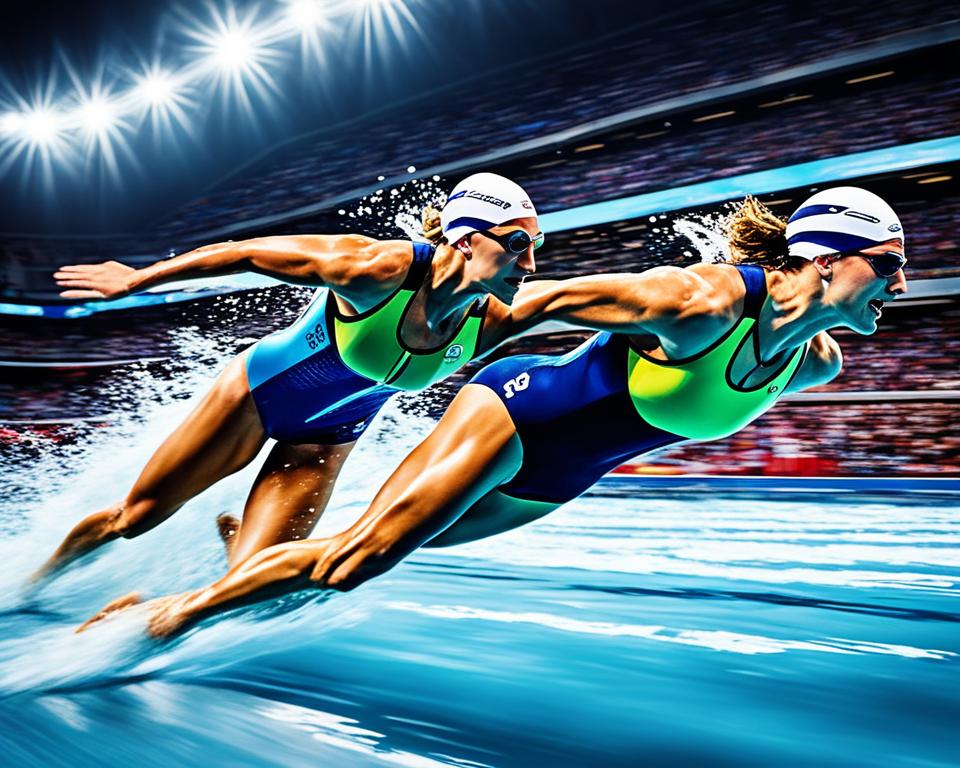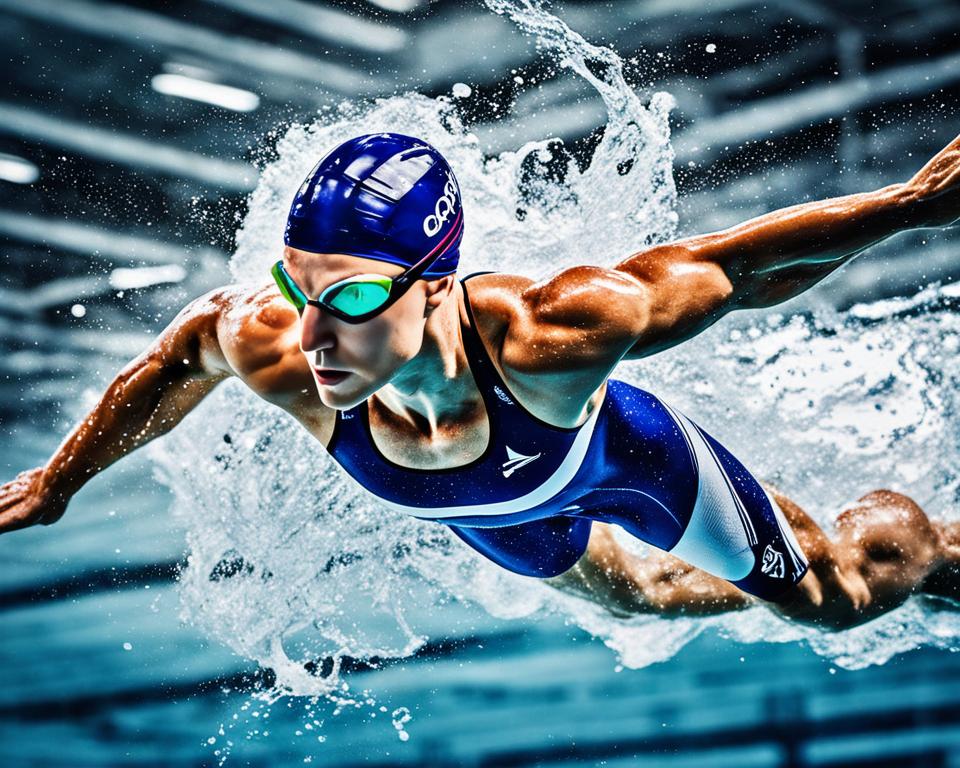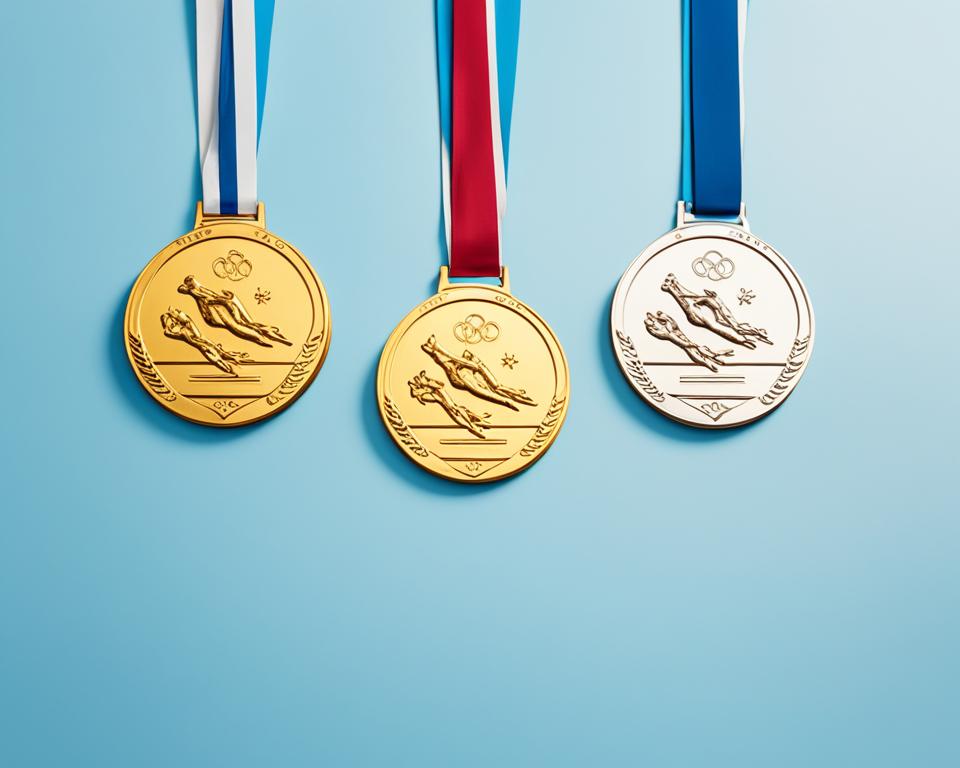Olympic swimming medals are a big deal, drawing attention from around the world. Athletes from every corner come together to show their swimming talents. They break records and feel the thrill of winning gold. This story looks at the exciting world of Olympic swimming. We’ll cover the top achievements, how swimming contests have changed, and the tales of swimming legends.
The Olympic swimming pool beams with excitement. Here, top swimmers make history and achieve greatness. Their victories and record-setting swims have inspired fans everywhere. This article uncovers the magic of Olympic swimming medals. We’ll share unforgettable moments and stories that shaped the sport.
Read more interesting information at ::zcr157602
The Pinnacle of Aquatic Excellence
The Olympic swimming medals mark the top of aquatic excellence. Here, the best swimmers from around the world show their amazing skills. They bring the Olympic spirit to life in the swimming pool. They work hard to make history and achieve their goals, creating moments of prestigious triumph.
The Olympic Spirit in the Swimming Pool
The Olympic spirit brings all the swimmers together. It goes beyond nations, creating a feeling of friendship and fair play. Every swimmer shares a dream: to break records and win. This spirit is what makes watching the Olympic swimming events so exciting and touching.
Prestigious Moments of Triumph
The swimming pool at the Olympics has seen truly outstanding achievements. With world-record breaks and exciting wins, these events are unforgettable. They inspire many future swimmers. The athletes who do well here become more than just winners. They become inspirations and legends.
“The Olympics are a wonderful metaphor for world cooperation, the kind of international competition that’s wholesome and healthy, an interplay between countries that represents the best in all of us.” – John Williams
Olympic Swimming Medals: Records and Legends
The Olympic swimming medals showcase amazing athletes who broke records. These include legends like Michael Phelps and Katie Ledecky. They have inspired many swimmers to aim high and redefine what’s possible.
Michael Phelps stands out with an incredible 28 Olympic medals. Among these, he has a stunning 23 gold medals. His achievements make him a top figure in swimming, setting the bar very high. Yet, his work also motivates others to reach for their dreams.
“I think goals should never be easy, they should force you to work, even if they are uncomfortable at the time.” – Michael Phelps
Katie Ledecky has also marked her place among the top with numerous Olympic medals. Her style in the pool is unmatched. She has broken many records and secured several golds. This has sealed her as one of the leading female swimmers ever.
These stars, among others, have transformed the sport. They encourage many to follow their passion for swimming. They show us how determination and resilience can lead to great success.
- Michael Phelps: 28 Olympic Medals (23 Gold, 3 Silver, 2 Bronze)
- Katie Ledecky: 7 Olympic Medals (7 Gold)
- Mark Spitz: 11 Olympic Medals (9 Gold, 1 Silver, 1 Bronze)
- Caeleb Dressel: 5 Olympic Medals (7 Gold)
- Larisa Latynina: 18 Olympic Medals (9 Gold, 5 Silver, 4 Bronze)
Their influence on swimming and aspiring athletes will continue. The legacy they’ve left is not only in records but also in the dreams they’ve ignited in many hearts.
The Art of Swimming Strokes
Olympic swimming showcases various strokes with unique challenges. From the smooth freestyle to the strong butterfly, each requires deep knowledge of how to move in water.
Mastering the Freestyle Stroke
The freestyle stroke is key in competitive swimming. It’s known for straight-arm recovery. Swimmers keep their face in the water much of the time.
Good freestyle form means a straight body, strong kick, and smooth arm movements. These elements let a swimmer move fast with less effort.
To be a top freestyle swimmer, you need to practice a lot. Improve your body position, breathing, and how arm and leg motions flow together. This is how top athletes reach amazing speeds.
The Power of the Butterfly Stroke
The butterfly stroke shows off the skill and power of Olympians. It’s done with a wave-like motion, needing strong core, power, and perfect timing.
Getting the butterfly stroke right needs both fitness and knowing how water works. Swimmers turn their body’s energy into speed, fighting the water’s pull. This challenging stroke showcases athletes like no other.
From the elegant freestyle to the demanding butterfly, each swimming stroke shows what it takes to be an Olympic athlete. By learning and practicing these skills, athletes push the limits of their bodies to achieve success.
Training Regimens of Olympic Swimmers
To reach the top in swimming, athletes must commit to tough training. This involves hard work to improve their skills, getting ready for big swim meets worldwide.
Olympic swimmers focus on exercises that test their bodies and improve their techniques. They spend lots of time on their strokes, becoming better at handling long swims, and fine-tuning their movements.
- Cardiovascular Conditioning: Olympic swimmers push their bodies with long swims and intense workouts. They also do exercises like running and cycling. This helps them build the stamina and strength they need.
- Strength Training: Building strength is key for swimmers. It helps them power through starts, turns, and finishes. This is crucial for their races.
- Technique Refinement: Expertise in swimming moves is essential for success. Swimmers work hard to perfect their strokes and movements to swim faster and more efficiently.
- Mental Preparation: Swimmers also train their minds for competition. They use techniques like visualizing success, setting goals, and developing strategies to stay focused and strong during races.
Becoming an Olympic champion in swimming is no small feat. It requires a level of dedication and effort that few others can match. These athletes aim for the heights of swimming, guided by their commitment to training and their dream of victory.
| Training Component | Focus | Frequency |
|---|---|---|
| Cardiovascular Conditioning | Endurance, Aerobic Capacity | Daily, 1-2 hours |
| Strength Training | Power, Explosiveness | 3-4 times per week, 1 hour sessions |
| Technique Refinement | Stroke Mechanics, Efficiency | Daily, 1-2 hours |
| Mental Preparation | Focus, Resilience, Visualization | Daily, 30-60 minutes |
“The pain of training is nothing compared to the pain of defeat.” – Unknown
The journey of Olympic swimmers showcases their drive for success. This journey combines intense physical, technical, and mental training. With every effort, they aim to redefine the limits of their sport and claim top honors in swimming.
The Evolution of Swimming Competitions
The story of swimming contests is truly fascinating. It has moved from ancient events to our current Olympic Games. This change displays the amazing growth of the sport, always meeting new challenges.
From Ancient to Modern Olympics
Swimming contests have been around for a long time, dating back to ancient times. The first known events were part of the ancient Olympic Games in Greece. Here, athletes competed in various water activities to prove their skills.
Swimming contests changed over time, adding new styles, methods, and technology. The revival of the Olympic Games in 1896 has greatly influenced swimming. Now, the Olympic swimming events are thrilling, showcasing amazing talent and dreams of victory.
The shift from ancient swimming contests to today’s Olympic swimming events is a story of success, achievements, and memorable moments. The sport, always improving, represents our drive for greatness and the urge to go beyond limits.
Swimming Events at the Olympics
The Olympic swimming program features various events. From exciting individual races to amazing relay races. Athletes from around the world show off their speed and skills, making it a thrilling event for everyone.
Individual Races
At the Olympics, individual swimming races are very intense. Athletes compete in events like the super quick 50-meter freestyle and the tough 1500-meter race. They use different swimming styles and smart plans to win.
Knowing how to do each swimming style well is key. For example, swimmers master the freestyle and butterfly strokes to be the best.
Relay Races
Relay races bring even more excitement to the Olympics. In these, four swimmers on a team race together. It’s not just about personal skill; it’s also about working perfectly as a team and timing everything just right.
The level of excitement goes up as teammates pass on the race to each other. It’s always a question of who will touch the finish line first.
| Olympic Swimming Events | Individual Races | Relay Races |
|---|---|---|
| Freestyle | 50m, 100m, 200m, 400m, 800m, 1500m | 4x100m, 4x200m |
| Backstroke | 100m, 200m | 4x100m |
| Breaststroke | 100m, 200m | 4x100m |
| Butterfly | 100m, 200m | 4x100m |
| Individual Medley | 200m, 400m | 4x100m |
The Olympic swimming events offer a stage for the sport’s top athletes. They compete in fast races and exciting relays. It’s a time where every swimming stroke and strategy captivates the world.

Iconic Moments in Olympic Swimming History
The Olympic swimming medals have seen many iconic moments. Athletes have made history with their incredible performances. They’ve set new records and inspired others with their achievements. From the moment they dive in to their final touch at the wall, swimming legends have changed the sport forever. They’ve shown what it truly means to be the best in the world.
In 2016, American Michael Phelps and South African Chad le Clos had an epic showdown. This battle took place at the Rio Olympics. Phelps won, making it his 20th gold medal. This victory further proved Phelps was among the best, if not the best, of all time. His chase for glory has become a story for the ages.
In the 2008 Beijing Olympics, Phelps reached a mountaintop in his career. He brought home an incredible eight gold medals. These wins included both individual and relay events. Phelps’ achievements set a new standard of excellence in the sport. He stands as the greatest Olympian ever, his legacy secure.
In Olympic swimming history, team victories also shine brightly. At the 2008 Olympics, the U.S. women’s 4×100-meter medley relay team amazed the world. Their record-setting performance earned them a gold medal. Teamwork has been a key part of swimming success, showing what united effort can accomplish.
These iconic moments define Olympic swimming history. They highlight the incredible skill and drive of swimming legends. Their efforts have shown us the very limits of what humans can achieve in the water.
| Iconic Moment | Year | Athlete(s) | Significance |
|---|---|---|---|
| Phelps vs. le Clos Showdown | 2016 | Michael Phelps, Chad le Clos | Phelps’ 20th Olympic gold medal, solidifying his status as a swimming legend |
| Phelps’ Record-Breaking 8 Golds | 2008 | Michael Phelps | Cementing Phelps’ legacy as the most decorated Olympian of all time |
| U.S. Women’s 4x100m Medley Relay | 2008 | Natalie Coughlin, Megan Jendrick, Christine Magnuson, Lacey Nymeyer | Setting a new world record and claiming the gold medal |
These iconic moments in Olympic swimming history underline the power of perseverance. The stories of swimming legends show how far human determination can take us. They are a tribute to the spirit of the sport.
The Psychology of Competitive Swimming
Competitive swimming at the Olympic level needs more than just being physically fit. It also requires strong mental skills. We will explore how mental toughness and resilience play a vital role in becoming a top swimmer.
Mental Toughness in Competitive Swimming
Olympic swimming is very high-pressure. Competitors must be physically and mentally ready. They need to be focused, composed, and determined against tough competition. They must also push through tiredness and handle stress well.
Serious swimmers need to believe in themselves. They must stay focused and aim for the best. They also must be quick to make decisions and keep cool under pressure.
Developing Resilience in Competitive Swimmers
Resilience is key for champions. It allows them to learn from losses and stay motivated. They see challenges as chances to get better and grow.
To become resilient, swimmers must have a growth mindset. They should be good at recognizing and controlling their emotions. They use setbacks to learn and constantly improve.
Building mental toughness and resilience gives swimmers a strong psychological advantage. This, alongside physical training, helps them do well in the Olympics. Succeeding in elite swimming requires both physical and mental strength.
The Science Behind Swimming Techniques
Swimming is deeply tied to science. It looks at the movements in the water through hydrodynamics and biomechanics. These fields help us discover how swimmers can move in the most efficient and effective ways.
Hydrodynamics: The Key to Fluid Motion
Hydrodynamics is crucial for swimmers. It studies the motion of fluids and how it relates to swimming. The shape of a swimmer’s body and their movement affect their speed in water.
Swimmers work to lessen drag, which slows them down. They do this by maintaining a streamlined body, kicking efficiently, and using smooth arm movements. These actions reduce resistance in the water, making them faster.
Biomechanics: The Science of Movement
Biomechanics is about the mechanical parts of living things. It helps swimming by improving the power, efficiency, and endurance of the strokes. By looking at how muscles work in different strokes, athletes and coaches can get better.
One example is the freestyle stroke. It shows that keeping the elbows high and using the core are key. This stroke also uses hip and shoulder rotation for power. The butterfly stroke needs good timing and coordinated movements between arms and legs.
| Swimming Technique | Key Biomechanical Principles |
|---|---|
| Freestyle | High elbow position, core engagement, hip and shoulder rotation |
| Butterfly | Timing, body undulation, arm and leg synchronization |
| Backstroke | Streamlined body position, powerful leg kick, efficient arm pull |
| Breaststroke | Timing of the whip kick, body positioning, maintaining a streamlined glide |
Learning about swimming science helps coaches and athletes. They can make better training and become more successful.

“The more a swimmer understands the science behind their movements, the better they can optimize their technique and unlock their full potential.”
Michael Phelps: The Greatest Olympian
Michael Phelps is a legend in American swimming. He’s considered the greatest Olympian ever. His many achievements and records have changed Olympic swimming forever.
In 2000, at the Sydney Olympics, Phelps made history. He was the youngest male swimmer in 68 years to join the U.S. team. This start led to an amazing career.
| Olympic Games | Gold Medals | Total Medals |
|---|---|---|
| 2004 Athens | 6 | 8 |
| 2008 Beijing | 8 | 8 |
| 2012 London | 4 | 6 |
| 2016 Rio | 5 | 6 |
During his career, michael phelps collected 28 Olympic medals. This includes a stunning 23 gold medals. He holds many world records because of his unmatched skill.
“The difference between the impossible and the possible lies in a person’s determination.”
Phelps’ achievements weren’t just about talent. His success came from hard work and dedication. He always strived to be better through intense training.
He also helped the U.S. team win many gold medals in relays. His team skills matched his individual abilities.
michael phelps has made a lasting impact on swimming. His success has inspired many others and built a legacy for future athletes.
Controversies and Doping in Swimming
Swimming at the Olympics is a place where the best show their skill. It is a stage for outstanding human achievements in the water. Yet, this area of victory has seen its share of problems. There have been many controversies and doping cases that have questioned the sport’s honesty.
In its history, swimming has seen several controversies that rocked its core. There were disqualifications because of doubtful decisions by officials. Also, there have been big arguments about the fairness of high-tech swimsuits. These problems led to strong talks within the Olympic family.
One major issue in swimming is doping. Some athletes have used forbidden drugs. They included anabolic steroids and stimulants to get ahead unfairly. This cheating not only affected the athlete’s image. It also darkened the sport’s reputation as a whole.
The effects of these swimming scandals have been huge. They led to disqualifications, taken medals, and a less trust in the competition’s honesty. To fight against doping, authorities and anti-doping groups have made the tests harder and the punishments stricter. But, the struggle against doping is still difficult.
| Year | Controversy | Outcome |
|---|---|---|
| 2008 | Swimsuit Controversy | New regulations introduced, banning certain swimsuit designs |
| 2016 | Russian Doping Scandal | Several Russian swimmers banned from competing in the Olympics |
| 2022 | Transgender Eligibility Debate | New rules introduced, limiting transgender participation in women’s events |
The swimming world is still facing these issues today. Finding fair solutions and protecting the sport’s values is very important. By dealing with the controversies and doping, Olympic swimming can truly be a model of sportsmanship and excellence.
“The integrity of the sport is essential. We must remain vigilant in our efforts to ensure a level playing field for all athletes.”
The Future of Olympic Swimming
As another exciting chapter in Olympic swimming ends, we look to the future. The sport’s future is dazzling. Athletes from all corners of the globe get ready to break new records. And, we can expect big changes in how we view competitive swimming too.
Emerging Talents and Innovations
The new era of swimming is all about fresh faces. Young swimmers with raw talent and an unstoppable drive are taking over. They’re setting new records in events like freestyle and butterfly.
And there’s more. Today, swimming is also about new tech. From cool swimwear to high-tech training gear, everything is changing. This new gear is not just making athletes better. It’s also teaching us new things about how our bodies move in the water.
